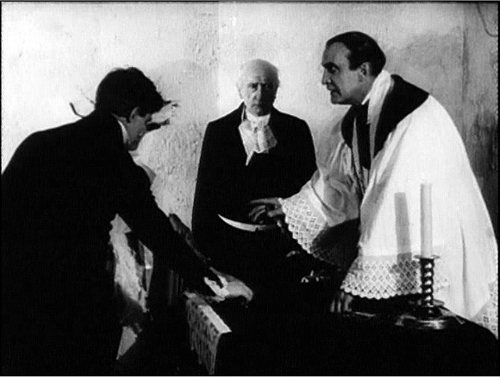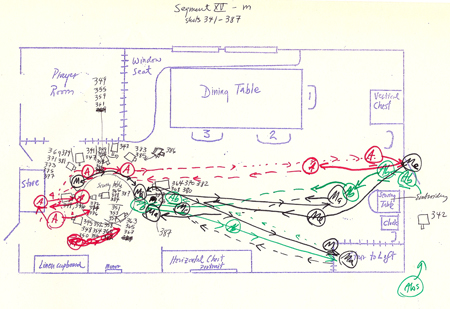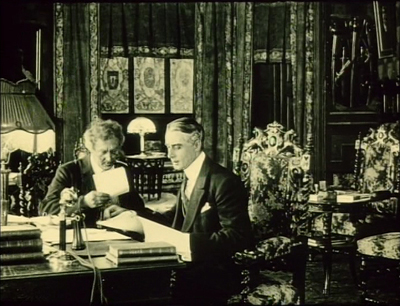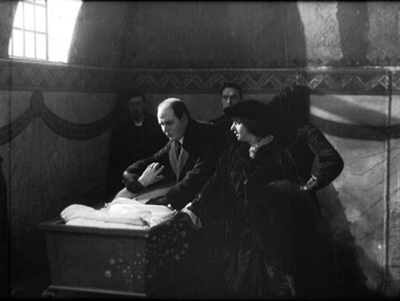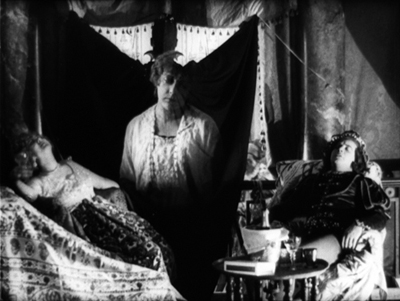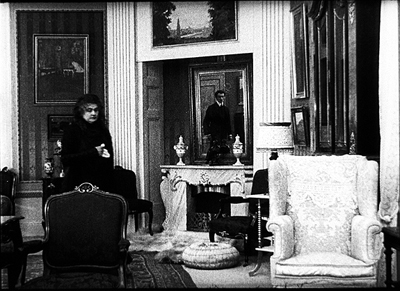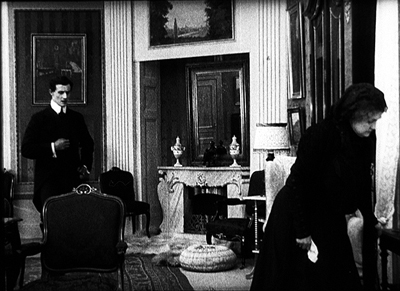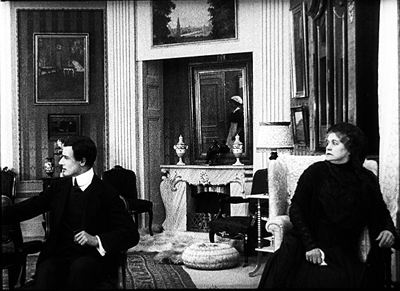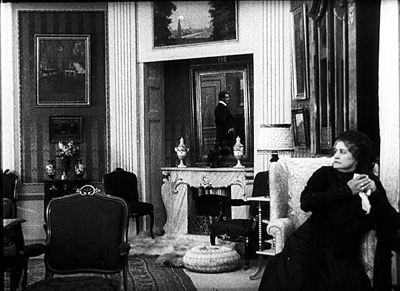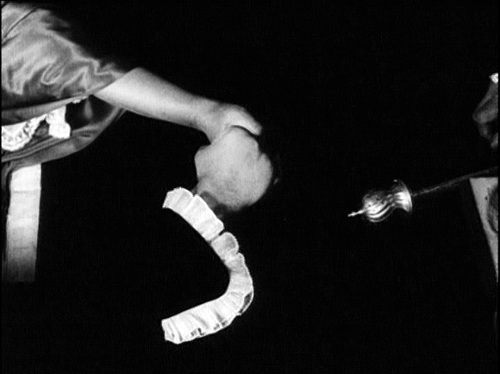Dreyer re-reconsidered
Monday | June 14, 2010 open printable version
open printable version
The President (1920).
DB here:
I was late to the feast, but my contribution to the Dreyer site is now up, thanks to Lisbeth Richter Larsen‘s quick work. You can read it here.
Danish cinema was the first national cinema I studied, and Dreyer was my point of entry. I went to Copenhagen in 1970 to see his films for a little book I wrote in the Movie/ Studio Vista series. The manuscript was finished but never published because the series ceased. Good thing for me. I’d be embarrassed today if that book was still floating out there.
Kristin and I went back to Copenhagen in 1976 to re-watch the Dreyer oeuvre, and I saw the films with new eyes. I had learned a lot more about film analysis and film history, so I was able to see different things in his movies. Now obsessed with how films construct space and time, I drew up elaborate and clumsy plans of actor blocking, camera setups, and camera movements.
What? You don’t recognize this as a string of shots from Day of Wrath? I even notated actor movements offscreen (with dotted lines).
The result of all this fussbudgetry was a 1981 book on Dreyer. I think that some of the ideas there still hold up. But as I learned more about film history in the 1990s, I came to believe that some of my conclusions were off-base.
In particular, my treatment of Gertrud as a radical, deliberately “empty” film seemed tenuous. Influenced by minimalist cinema of the 1970s, especially that of Straub and Huillet (huge admirers of Dreyer), I pushed the case that at the end of his life Dreyer dared to make a movie that was by all ordinary standards simply boring.
Steadier heads tried to talk me out of it, but I clung to the idea. What can I say? I was young and stubborn.
As I studied more cinema of the 1910s, I began to see Dreyer’s career, and particularly his silent films, as tied in complicated ways to other films of that period–not least Danish cinema. For, as I’ve sketched here, Danish cinema of the 1910s was one of the richest traditions of “tableau” staging in Europe. I was able to put my ideas about the Danes’ achievements into clearer form in the last chapter of On the History of Film Style and in an invited essay on the Nordisk company published in a collection at the Danish Film Institute.
Like their peers in other countries, the Danes often stuffed their shots with furniture and props, in a riot of patterns and textures. Here is an example from Den Frelsende Film (The Woman Tempted Me, 1916). It survives only in fragments, but those fragments are in fine shape.
In addition, the Danes developed elaborate lighting patterns and complex, somewhat Gothic special effects. You can see these options in Ekspressens Mysterium (Alone with the Devil, 1914) and Doktor Voluntas (1915).
Above all there was the intricate staging in depth, often using mirrors. Here’s a seldom-seen example. In Under Blinkfyrets Straaler (Under the Lighthouse Beam, 1913), the father has died, and his wife and son meet in the parlor. A mirror catches them entering, in phases.
The mirror shows Hugo entering the room by moving straight and forward, but when he gets into the shot he comes in somewhat diagonally from the left.
After a moment of sitting in silence, mother and son turn as a maid enters. They look off left, but because we’ve seen Hugo enter in the mirror, we look to the center and see her reflection as she shuts the door.
The maid brings the widow a letter from her other son, Robert. Hugo, fretful, departs and in the mirror we see him look back at his mother.
Or does he? The angle of his glance makes sense compositionally: In reflection Hugo seems to be meeting his mother’s eyes, left to right. But in my first frame, he advanced into the room by looking straight ahead. If he looked straight into the room again now, he’d be looking more or less at us, not at his mother. So I suspect that in my last frame, the actor is actually not looking directly at the actress but off at an angle. He has been directed to this position to allow the mirror to create an artificial, but highly readable, image.
The novice Dreyer, I realized, didn’t indulge in such tableau trickery. His first two films, The President (made in 1918) and Leaves from Satan’s Book (made in 1919), are quite different from the norms that ruled his local cinema. By the time he came to directing, he was more oriented toward analytical editing and fairly flat staging than were the old guard. In this regard he was closer to a younger group of filmmakers emerging at the same time in other countries: Gance, Lang, Murnau, Joe May, and many others, along with Americans like Ford, Walsh, et al. So my newest take is that Dreyer is part of a generation of directors moving toward an editing-driven cinema and away from the tableau style. This idea in turn helped me see Gertrud in a more convincing light.
If you want the argument in full, you can check it on the Dreyer site. The lesson for me is twofold. (A) Dreyer is inexhaustible. (B) The more you learn about cinema (and about life), the more you can see in films that you think you have already understood.
The only book in English surveying the cinema of Dreyer’s elders is Ron Mottram’s indispensable The Danish Cinema before Dreyer (Metuchen, NJ: Scarecrow, 1988). It doesn’t consider the dual traditions of staging and editing, but it offers a very thorough history of studios, directors, and genres, and mentions some stylistic patterns. The article I referred to is “Nordisk and the Tableau Aesthetic” in Lisbeth Richter Larsen and Dan Nissen, eds., 100 Years of Nordisk Film (Copenhagen: Danish Film Institute, 2006), 80-95. This gorgeous book can be ordered from the DFI shop;I’ll be adding my essay here some time this summer.
For more on the tableau tradition, go to other blog entries here and here and here and here. On the emergence of continuity editing, chiefly in the US, try here and here and here. More detailed treatments are in The Classical Hollywood Cinema, On the History of Film Style, and Figures Traced in Light: On Cinematic Staging.
I’m grateful as ever to Marguerite Engberg, Dan Nissen, Thomas Christensen, and Mikael Brae for their help in my research on Danish silent film.
PS 16 June: Jonathan Rosenbaum has republished on his site his detailed and engrossing 1985 study of Gertrud, which includes discussion of the play from which Dreyer adapted his film. Thanks to Jonathan for making his essay available.
The President (1920).












